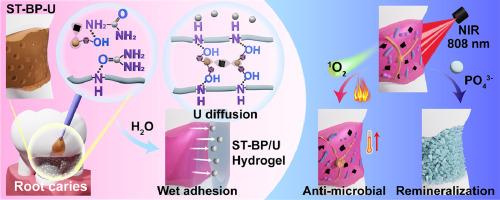Hagfish-inspired hydrogel for root caries: A multifunctional approach including immediate protection, antimicrobial phototherapy, and remineralization
IF 9.4
1区 医学
Q1 ENGINEERING, BIOMEDICAL
引用次数: 0
Abstract
Root caries is the main cause of oral pain and tooth loss in the elderly. Protecting root lesions from environmental disturbances, resisting pathogens, and facilitating remineralization over time are essential for addressing root caries, but are challenging due to the irregular root surface and the complex oral environment. Hagfish secretes slime when facing danger, which converts into gels upon contact with seawater, suffocating the predators. Inspired by hagfish's defense mechanism, a fluid-hydrogel conversion strategy is proposed to establish a mechanical self-regulating multifunctional platform for root caries treatment. The fluid system (silk fibroin-tannic acid-black phosphorene-urea, ST-BP-U), in which urea disrupts the hydrogen bonds between silk fibroin and tannic acid, can easily spread on the irregular root surface and permeate into dentinal tubules. Upon contact with the surrounding water, urea diffuses, prompting the hydrogel re-formation and creating intimate attachments with micromechanical inlay locks. Meanwhile, BP increases the crosslinking of the re-formed hydrogel network, resulting in reinforced cohesion for robust wet adhesion to the tooth root. This process establishes a structured platform for effective antimicrobial phototherapy and dentin remineralization promotion. This water-responsive fluid-hydrogel conversion system adapts to the irregular root surface in the dynamic wet environment, holding promise for addressing root caries.
Statement of significance
Root caries bring a heavy burden to the aging society, but the irregular root surface and dynamic moist oral environment always hinder non-surgical therapeutic effects. Here, we propose a water-responsive fluid-hydrogel conversion strategy aimed at mechanical self-regulation on the irregular and wet root interface to construct a functional structural platform. The liquid system (ST-BP-U) that prebreak intermolecular hydrogen bonds can easily spread on irregular surfaces and dentin tubules. When encountering water, hydrogen bonds re-form, and BP increases the crosslinking of the hydrogel formed in situ. Based on this firm wet-adhesion platform, it provides powerful phototherapy effects and promotes dentin remineralization. This fluid-hydrogel conversion system turns the disadvantages of wet environment into advantages, offering a promising strategy for root caries.

Hagfish-Inspired Hydrogel for Root Caries:包括即刻保护、抗菌光疗和再矿化在内的多功能方法
根龋是老年人口腔疼痛和牙齿脱落的主要原因。保护牙根病变免受环境干扰、抵抗病原体和促进长期再矿化是解决根龋问题的关键,但由于牙根表面不规则,口腔环境复杂,因此具有挑战性。旗鱼在面临危险时会分泌粘液,粘液与海水接触后会转化为凝胶,使捕食者窒息而死。受姬鱼防御机制的启发,我们提出了一种流体-水凝胶转换策略,以建立一个用于根龋治疗的机械自调节多功能平台。这种流体系统(丝纤维素-单宁酸-黑磷脂-尿素,ST-BP-U)中,尿素破坏了丝纤维素和单宁酸之间的氢键,可以很容易地在不规则的牙根表面扩散并渗透到牙本质小管中。与周围的水接触后,尿素扩散,促使水凝胶重新形成,并与微机械嵌体锁形成紧密附着。同时,BP 会增加重新形成的水凝胶网络的交联度,从而增强内聚力,实现与牙根的牢固湿粘附。这一过程为有效的抗菌光疗和促进牙本质再矿化建立了一个结构化平台。这种水响应流体-水凝胶转换系统能在动态湿环境中适应不规则的牙根表面,有望解决牙根龋问题。意义说明:龋齿给老龄化社会带来沉重负担,但不规则的牙根表面和动态潮湿的口腔环境始终阻碍着非手术治疗效果。在此,我们提出了一种水响应流体-水凝胶转换策略,旨在对不规则和潮湿的牙根界面进行机械自调节,从而构建一个功能性结构平台。预先断开分子间氢键的液体体系(ST-BP-U)可以很容易地在不规则表面和牙本质小管上扩散。当遇到水时,氢键会重新形成,BP 会增加原位形成的水凝胶的交联度。基于这种牢固的湿粘附平台,它能提供强大的光疗效果并促进牙本质再矿化。这种流体-水凝胶转换系统将湿环境的劣势转化为优势,为治疗根龋提供了一种前景广阔的策略。
本文章由计算机程序翻译,如有差异,请以英文原文为准。
求助全文
约1分钟内获得全文
求助全文
来源期刊

Acta Biomaterialia
工程技术-材料科学:生物材料
CiteScore
16.80
自引率
3.10%
发文量
776
审稿时长
30 days
期刊介绍:
Acta Biomaterialia is a monthly peer-reviewed scientific journal published by Elsevier. The journal was established in January 2005. The editor-in-chief is W.R. Wagner (University of Pittsburgh). The journal covers research in biomaterials science, including the interrelationship of biomaterial structure and function from macroscale to nanoscale. Topical coverage includes biomedical and biocompatible materials.
 求助内容:
求助内容: 应助结果提醒方式:
应助结果提醒方式:


